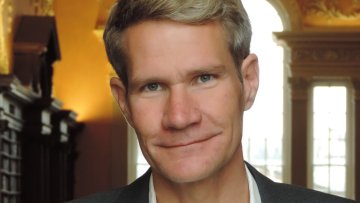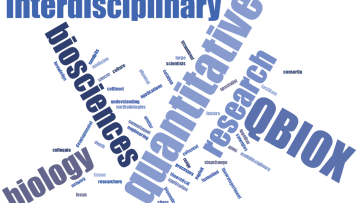Oxford Mathematician Per-Gunnar Martinsson has been awarded the 2017 Germund Dahlquist Prize by the Society for Industrial and Applied Mathematics. The Germund Dahlquist Prize is awarded for original contributions to fields associated with Germund Dahlquist, especially the numerical solution of differential equations and numerical methods for scientific computing.
Connecting the ambitwistor and the sectorized heterotic strings
Abstract
Shortly after Mason & Skinner introduced the so-called ambitwistor strings, Berkovits came up with a pure-spinor analogue of the theory, which was later shown to provide the supersymmetric version of the Cachazo-He-Yuan amplitudes. In the heterotic version, however, both models give somewhat unsatisfactory descriptions of the supergravity sector.
In this talk, I will show how the original pure-spinor version of the heterotic ambitwistor string can be modified in a consistent manner that renders the supergravity sector treatable. In addition to the massless states, the spectrum of the new model --- which we call sectorized heterotic string --- contains a single massive level. In the limit in which a dimensionful parameter is taken to infinity, these massive states become the unexpected massless states (e.g. a 3-form potential) first encountered by Mason & Skinner."
16:00
The Quantum Steenrod Square and its Properties
Abstract
Topologists have the Steenrod squares, a collection of additive homomorphisms on the Z/2 cohomology of a space M. They can be defined axiomatically and are often be regarded as algebraic operations on cohomology groups (for many purposes). However, Betz and Cohen showed that they could be viewed geometrically.
Symplectic geometers have quantum cohomology, which on a symplectic manifold M is a deformation of singular cohomology using holomorphic spheres.
The geometric definition of the Steenrod square extends to quantum cohomology. This talk will describe the Steenrod square and quantum cohomology in terms of the intersection product, and then give a description of this quantum Steenrod square by putting these both together. We will describe some properties of the quantum squares, such as the quantum Cartan formula, and perform calculations in certain cases.
16:00
C^infinity Algebraic Geometry (with corners)
Abstract
Manifolds, the main objects of study in Differential Geometry, do not have nice categorical properties. For example, the category of manifolds with smooth maps does not contain all fibre products.
The algebraic counterparts to this (varieties and schemes) do have nice categorical properties.
A method to ‘fix’ these categorical issues is to consider C^infinity schemes, which generalise the category of manifolds using algebraic geometry techniques. I will explain these concepts, and how to translate to manifolds with corners, which is joint work with my supervisor Professor Dominic Joyce.
Algorithms for finitely presented groups, and strong approximation.
Representations of pseudo-reductive groups
Abstract
Pseudo-reductive groups are smooth connected linear algebraic groups over a field k whose k-defined unipotent radical is trivial. If k is perfect then all pseudo-reductive groups are reductive, but if k is imperfect (hence of characteristic p) then one gets a strictly larger collection of groups. They come up in a number of natural situations, not least when one wishes to say something about the simple representations of all smooth connected linear algebraic groups. Recent work by Conrad-Gabber-Prasad has made it possible to reduce the classification of the simple representations of pseudo-reductive groups to the split reductive case. I’ll explain how. This is joint work with Mike Bate.
QBIOX – Quantitative Biology in Oxford – is a new network that brings together biomedical and physical scientists from across the University who share a commitment to making biology and medicine quantitative. A wide range of bioscience research fields are interested in the behaviour of populations of cells: how they work individually and collectively, how they interact with their environment, how they repair themselves and what happens when these mechanisms go wrong.
16:00
Quiver varieties revisited
Abstract
Quiver varieties are an attractive research topic of many branches of contemporary mathematics - (geometric) representation theory, (hyper)Kähler differential geometry, (symplectic) algebraic geometry and quantum algebra.
In the talk, I will define different types of quiver varieties, along with some interesting examples. Afterwards, I will focus on Nakajima quiver varieties (hyperkähler moduli spaces obtained from framed-double-quiver representations), stating main results on their topology and geometry. If the time permits, I will say a bit about the symplectic topology of them.
16:00
The Drinfeld Centre of a Symmetric Fusion Category
Abstract
This talk will be a gentle introduction to braided fusion categories, with the eventual aim to explain a result from my thesis about symmetric fusion categories.
Fusion categories are certain kinds of monoidal categories. They can be viewed as a categorification of the finite dimensional algebras, and appear in low-dimensional topological quantum field theories, as well as being studied in their own right. A braided fusion category is additionally commutative up to a natural isomorphism, symmetry is an additional condition on this natural isomorphism. Computations in these categories can be done pictorially, using so-called string diagrams (also known as ``those cool pictures'').
In this talk I will introduce fusion categories using these string diagrams. I will then discuss the Drinfeld centre construction that takes a fusion category and returns a braided fusion category. We then show, if the input is a symmetric fusion category, that this Drinfeld centre carries an additional tensor product. All of this also serves as a good excuse to draw lots of pictures.
Toward attaining turbulent dynamos in the laboratory
Abstract
The existence of planetary and stellar magnetic fields is attributed to the dynamo instability, the mechanism by which a background turbulent flow spontaneously generates a magnetic field by the constructive refolding of magnetic field lines. Many efforts have been made by several experimental groups to reproduce the dynamo instability in the laboratory using liquid metals. However, so far, unconstrained dynamos driven by turbulent flows have not been achieved in the intrinsically low magnetic Prandtl number $P_m$ (i.e. $Pm = Rm/Re << 1$) laboratory experiments. In this seminar I will demonstrate that the critical magnetic Reynolds number $Rm_c$ for turbulent non-helical dynamos in the low $P_m$ limit can be significantly reduced if the flow is submitted to global rotation. Even for moderate rotation rates the required energy injection rate can be reduced by a factor more than 1000. Our finding thus points into a new paradigm for the design of new liquid metal dynamo experiments.



